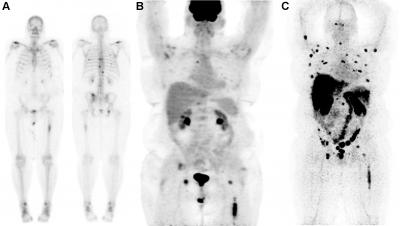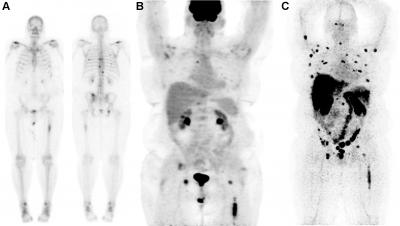
Credit: Neeta Pandit-Taskar, M.D., and Michael J. Morris, M.D., Memorial Sloan Kettering Cancer Center
New research demonstrates that a novel imaging agent can quickly and accurately detect metastasis of prostate cancer, even in areas where detection has previously been difficult. Published in the December issue of The Journal of Nuclear Medicine, the Phase 1 dose-escalation study of Zr-89-desferrioxamine-IAB2M (Zr-89-Df-IAB2M), an anti-PSMA (prostate-specific membrane antigen) minibody, in patients with metastatic prostate cancer shows its effectiveness in targeting both bone and soft tissue lesions.
"This agent is imaged faster than other PSMA-targeting imaging antibodies due to its small size and has been shown to be safe for patients," explains Neeta Pandit-Taskar, MD, of the Memorial Sloan Kettering Cancer Center in New York City. "The radiotracer combines a small amount of the radioactive material zirconium-89 with a fragment of an antibody called a minibody. This minibody has anti-PSMA qualities and attaches to overexpression of the enzyme on the exterior of prostate cancer cells, wherever they may have traveled in the body. Particles emitted from the site are then detected by positron emission tomography (PET). The resulting scan highlights 'hot spots' of PSMA overexpression." She adds, "Using this agent, we can detect the prostate cancer cells that have metastasized to bone–one of the most difficult areas to evaluate using standard methods."
For the study, 18 patients were imaged with the new agent using PET/CT as well as a variety of conventional imaging modalities, including computed tomography (CT), magnetic resonance imaging (MRI), molecular bone scan (SI), and PET with fluorodeoxyglucose (FDG-PET). Suspected disease sites were then selected and biopsied.
Both skeletal and nodal lesions were detected with Zr-89-Df-IAB2M; scans were positive in 17 of the 18 patients, with bone lesions targeted in 9 and soft tissue disease seen in 14. In comparison, bone scans with more traditional agents (Tc-99m-methylene diphosphonate and FDG) were positive for bone lesions in 9 and 6 patients, respectively; for nodal/soft tissue disease, CT and FDG scans were positive in 14 and 10 patients, respectively. In two patients, a single site of disease per patient was identified only by the minibody. In total, Zr-89-Df-IAB2M imaging detected 147 bone and 82 soft-tissue or nodal lesions.
"Results of imaging with this Zr-89 radiolabeled minibody have shown that we are able to detect more disease sites in patients than with conventional imaging," Pandit-Taskar states. "We hope that with further development this technology will help us in earlier and more accurate assessment of disease and assist in clinical decision-making." She points out, "With further validation, this agent could potentially be used for targeted biopsies, which could lead to more appropriate, timely treatment for prostate cancer patients. It may also have potential use in targeted radiotherapy."
According to the National Cancer Institute, in 2013 nearly 3 million men in the U.S. were living with prostate cancer. In 2016, more than 180,000 men in the U.S. are expected to be diagnosed with prostate cancer, and more than 26,000 are likely to die from the disease.
###
Authors of the article "First-in-Human Imaging with 89Zr-Df-IAB2M Anti-PSMA Minibody in Patients with Metastatic Prostate Cancer: Pharmacokinetics, Biodistribution, Dosimetry, and Lesion Uptake" include Neeta Pandit-Taskar, Jorge A. Carrasquillo, Jason S. Lewis, Steven M. Larson, Wolfgang A. Weber, Howard I. Scher, and Michael J. Morris, Memorial Sloan Kettering Cancer Center (MSK) and Weill Cornell Medical College (WCMC), New York, New York; Joseph A. O'Donoghue, Shutian Ruan, Serge K. Lyashchenko, Glenn Heller, Danny F. Martinez, Sarah M. Cheal, and Martin Fleisher, MSK; and Jennifer S. Keppler, Robert E. Reiter, and Anna M. Wu, ImaginAb, Inc., Inglewood, California.
This work was funded by ImaginAb, Inc.; DOD Clinical Consortium (#PC071610); and MSK's Radiochemistry & Molecular Imaging Probe Core and Biostatistics Core (CCSG P30 CA008748).
Please visit the SNMMI Media Center to view the PDF of the study, including images, and more information about molecular imaging and personalized medicine. To schedule an interview with the researchers, please contact Laurie Callahan at (703) 652-6773 or [email protected]. Current and past issues of The Journal of Nuclear Medicine can be found online at http://jnm.snmjournals.org.
About the Society of Nuclear Medicine and Molecular Imaging
The Society of Nuclear Medicine and Molecular Imaging (SNMMI) is an international scientific and medical organization dedicated to raising public awareness about nuclear medicine and molecular imaging, a vital element of today's medical practice that adds an additional dimension to diagnosis, changing the way common and devastating diseases are understood and treated and helping provide patients with the best health care possible.
SNMMI's more than 17,000 members set the standard for molecular imaging and nuclear medicine practice by creating guidelines, sharing information through journals and meetings and leading advocacy on key issues that affect molecular imaging and therapy research and practice. For more information, visit http://www.snmmi.org.
Media Contact
Laurie Callahan
[email protected]
@SNM_MI
http://www.snm.org
############
Story Source: Materials provided by Scienmag




